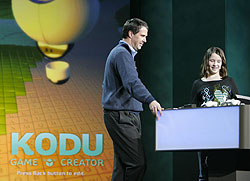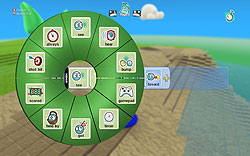REDMOND – Jan. 14, 2008 – For children, learning to program at an early age can open up a lifetime of creativity and opportunity. And with Kodu, a new game unveiled by Microsoft at the recent 2009 International Consumer Electronics Show (CES), they can learn the skill of programming while having fun creating and playing their own games.
Kodu will be released this spring on the Xbox Live Community Games channel and will help people of all ages program their own games in addition to exercising their logic and problem-solving skills, says Robbie Bach, president of Microsoft’s Entertainment and Devices Division. “It started as a way to help kids learn how to program, but what it’s turned into is a way to not only learn how to program, but to create your own games,” he says.

Microsoft Entertainment and Devices Division President Robbie Bach watches as 12-year-old Sparrow shows off her programming skills on the new Xbox Live Community game Kodu. Jan. 7, 2009, Las Vegas.
Kodu is built around a game-friendly programming language that is simple and icon-based. Players can choose from 20 different game characters – including flying saucers, submarines, and a Pac Man-like Kodu main character – then use an interactive terrain editor, a bridge and path builder, and other tools to create their own game world. Players also have the option of using pre-loaded worlds.
Kodu is a product of Microsoft Research, where it was developed over the past two years by principal program manger designer Matt MacLaurin. His goal: Create a game his four-year-old daughter could use to both have fun and learn something about programming.
MacLaurin said he and others on the project were fans of the Logo programming language, which was created for educational use, and believed there was something to be accomplished with it in the area of programming and gaming. In 2006, Microsoft Research teamed up with Girls Inc. and the University of Santa Barbara to create an after-school Kodu program to accurately measure the influence educational games have in the fields of math, science, and comprehension. The team logged hundreds of hours of Kodu research with creators from ages five to 45 to ensure that it is easy for beginners, but maintains a depth of content for those who are more advanced.
Players begin by choosing from a set of almost 200 visual building blocks and then use an image-based creator menu to build a world based on physical action and reaction – when a character performs an action, the game world reacts to it. Gamers have the ability to use hearing, vision and time to control their character’s behavior. Though the game is aimed at a younger demographic, people of all ages have played and enjoyed Kodu, MacLaurin said. “We wanted to share with kids the ways in which programming is fun,” he says. “We consider it a game and a creative tool, and I think one of the things that makes it magical is that it is both.”
Kodu can be used and played on either a PC or an Xbox 360.
On stage at CES, Bach had help demonstrating the game from 12-year-old Sparrow, who tested the game during its development and is now a whiz at Kodu. She briefly showed a bemused Bach how to program aspects of a game she made up, and then they played it together.
“What I love about Kodu is that I can do everything myself,” said Sparrow as she rapidly and expertly programmed the game, making the keynote crowd chuckle at her speed and proficiency. “It’s fast to build and different from the other games I play. I can do cool, silly things in it!”
She and Bach then competed in the simple game she created, which involved gathering shiny rocks and taking them to a little house. She, as the kids say, “pwnd” Bach, beating him at her game in minutes.
MacLaurin said working in Microsoft Research, and the entire Kodu-creating experience, was “awesome.”
“It’s great. I’ve spent a lot of my career in research, incubations, and commercial projects,” he says. “So much of the time you have to choose (between) the thing that’s really cutting edge, or the thing that’s going to ship. This crosses over both.”
Kodu tested well with kids, educators, and parents, an impressive feat for a video game.

Kodu features a visually-based creation wheel, allowing users to create their own logic-based game.
“For kids, it’s super empowering. They spend so much time in these game worlds and don’t get to have any say in how the game looks or feels,” MacLaurin said. “Now they can build something that’s really new. That’s the most exciting thing for me – they really do appreciate the creative empowerment.”
Another benefit of the game, one its creators hadn’t fully considered, is how well it teaches problem solving skills. In testing, MacLaurin watched youngsters debug their own programming code. He realized they were creating and then solving their own problems.
“It’s exciting to watch,” he says of the process. And it can have big payoffs later. “The concept is that mental skills you use in programming are used in other aspects of life. (Building) brain skills that are actually as useful for writing a business plan as they are for writing code. There’s a growing appreciation there.”
In 2006, Microsoft Research teamed up with Girls Inc. and the University of Santa Barbara to create an after-school Kodu program to accurately measure the influence educational games have in the fields of math, science, and comprehension. The team logged hundreds of hours of Kodu research with creators from ages five to 45 to ensure that it is easy for beginners, but maintains a depth of content for those who are more advanced.
Bach says there has been an outpouring of creativity since the Xbox group launched its Community Games Channel, which allows independent developers to create and share games. Since its launch this past November, the Community Games Channel has gained a following among both consumers and game-makers, and there now are more than 100 community-created game titles available.




